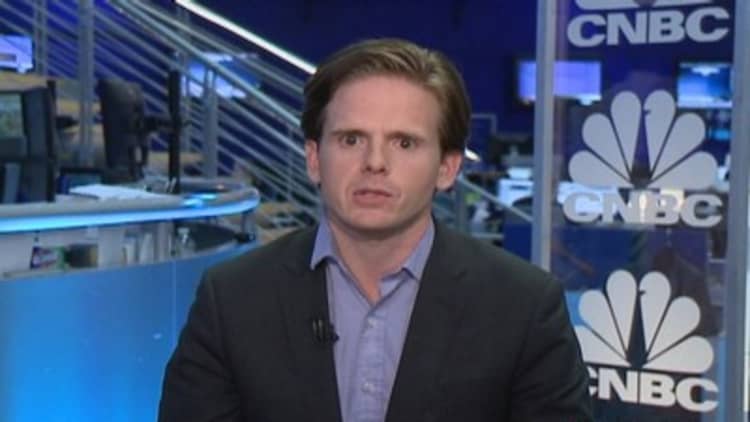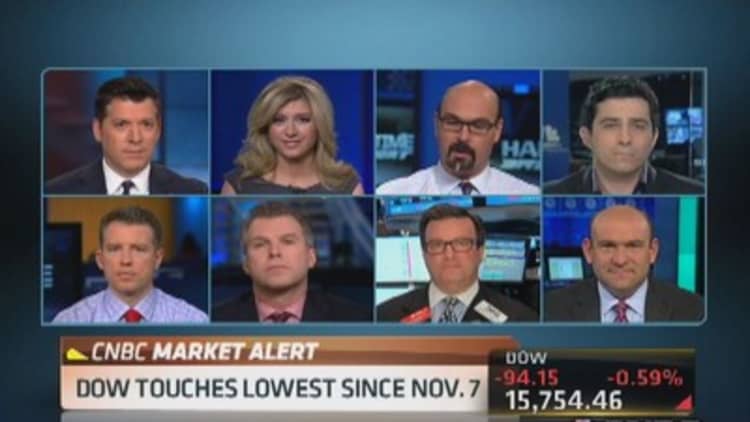
Heated debate about the stock market being rigged has dragged on since the publication of "Flash Boys," Michael Lewis' book about high-frequency traders. But there's another set of players on Wall Street who may not be giving regular investors their fair share: ETF managers.
Consider the iShares Nasdaq Biotechnology ETF, ticker IBB, which has pulled back sharply in the recent tech selloff after rocketing 65 percent higher in 2013.
What may surprise some investors is how BlackRock, the manager of IBB, generates extra income: By lending the ETF's stocks to short sellers. That practice can generate significant income for smaller stocks because short sellers will sometimes pay hefty fees for the right to borrow them.
At the end of September, the most recent reporting period available, IBB had lent out shares worth $651 million, or about 16 percent of the ETF's assets.
Read MoreMeet the poster child for momentum stock selloff
First, the idea that an ETF is helping short sellers bet against its shares might not sit well with IBB investors, especially in light of the recent selloff. But an arguably more important question is how much of the stock-lending income actually went back to ETF investors and how much BlackRock kept for itself.
In the six months through September, IBB generated $5.48 million in securities lending revenue. Some $3.56 million, or 65 percent of the total, went back into the ETF itself. But BlackRock kept the remaining $1.92 million for itself.
Read MoreThe dumbing down of smart beta ETFs
The numbers are larger for some other ETFs that have more money under management. For instance, the iShares Russell 2000 ETF generated $37.7 million in stock-lending fees in the six months through September. Again, only $24.5 million of that went back into the ETF, with Blackrock keeping $13.2 million.
Of course, investors in the iShares ETFs are probably happy to receive some of the benefit from stock lending, even if the manager keeps a chunk for itself. The annualized benefit of stock lending for IBB investors was about 0.21 percentage point in the six months through September, compared with an annual management fee of 0.48 percentage point.
Even so, IBB lagged its underlying benchmark over the same time period, when its net asset value rose 31.08 percent compared with 31.13 percent for the Nasdaq Biotechnology Index.
While that difference may seem small, a few basis points every year over several years can eventually mean real money for long-term investors. And some other ETF managers share a larger percentage of stock-lending revenue with ETF investors.
Take State Street, which manages the SPDR ETFs. It returns 85 percent of stock lending revenue to its ETFs and keeps only 15 percent for itself. The SPDR S&P Biotech ETF generated $3.4 million of stock-lending revenue in the six months through December, of which $2.9 million went back into the ETF.
That revenue equates to an annualized 62 basis points, more than enough to offset the ETF's 0.35 percent annual management fee. It also helped the ETF beat its benchmark: The SPDR S&P Biotech ETF's net asset value rose 25.08 percent in the six months through December, versus a 24.92 percent rise in the S&P Biotech Index.

To be fair, investors shouldn't always expect stock lending to generate such outsized returns. While the SPDR S&P Biotech ETF has generated enough stock lending fees to offset the management fee in the last couple of years, the annual benefit was less than 62 basis points.
Read MoreETF managers tailor-made for a volatile market
For its part, BlackRock has become more investor friendly over the last several years. Back in 2010, it increased the amount of stock-lending fees reinvested in its ETFs to 65 percent from 50 percent. And as of January 2014, the percentage was increased to 70 percent to 75 percent across its various ETFs.
BlackRock said it "believes the net returns to shareholders, balanced with appropriate risk and fee disclosure, is the best gauge of investor benefits from securities lending, not simply the stated fee split. It is important to remember that some lenders are able to generate more return from a given basket of securities due to their scale and skill."
Securities lending can have much darker side. When stocks are loaned out, the borrower gives the lender collateral that can be invested elsewhere. AIG ran into big trouble during the crisis when it invested that collateral in toxic asset-backed securities and had to make a multibillion-dollar write-down.
Fortunately, BlackRock and State Street invest that money in short-term money market funds, which are far safer. But with the money in the ETF ultimately belonging to ETF investors, they should push for a big chunk of stock-lending income.
—By CNBC's John Jannarone.
UPDATED: This story was updated to include a statement from BlackRock.




